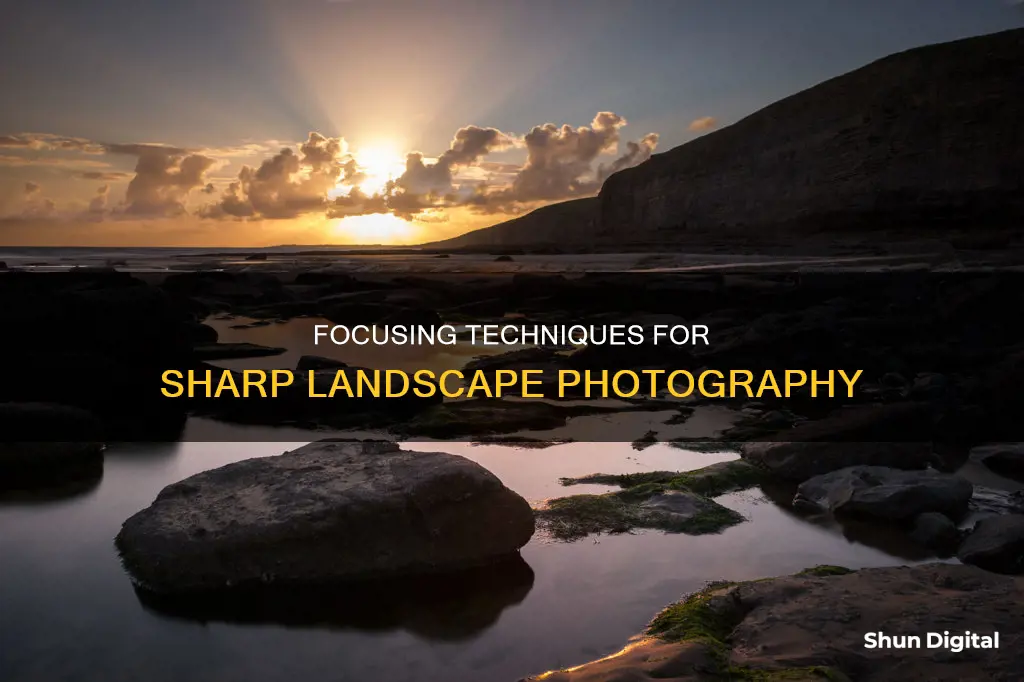
Focusing a camera is a crucial aspect of photography, as it determines the sharpness and clarity of the final image. The plane of focus refers to the region in space that can be made as sharp as possible in a photo. By adjusting the lens elements or physically moving the lens, photographers can change the optical path of light and thus the plane of focus.
Modern cameras offer two focusing options: autofocus and manual focus. Autofocus, a newer technology, uses a motor in the camera or lens to focus on a selected subject. It is convenient, fast, and accurate, especially for tracking moving subjects. However, manual focus allows for more precision and control, making it useful in low-light conditions or when the camera struggles to focus.
To achieve a photo with everything in focus, photographers can adjust the aperture, which controls the depth of field. A smaller aperture, denoted by larger f-numbers like f/16 or f/22, increases the depth of field, bringing both foreground and background elements into focus. Additionally, the hyperfocal distance—the distance at which the lens is focused to maximise the depth of field—can be calculated for a given aperture.
Another technique to ensure everything is in focus is to use focus stacking. This involves taking multiple photos focused at different points and then combining the sharpest parts of each image. This method is useful for macro and landscape photography but can be time-consuming and challenging if the subjects are moving.
| Characteristics | Values |
|---|---|
| Camera type | DSLR, point-and-shoot, smartphone |
| Focus type | Manual, autofocus |
| Focus ring | Ring around the lens that controls focus |
| Viewfinder | Small window to look through when taking a photograph |
| LCD screen | Can be used to fine-tune the focus |
| Zoom | Controls how close the subject appears |
| Aperture | Controls the amount of light that enters the lens |
| Shutter speed | Controls the brightness of the photograph |
| ISO | Controls the brightness of the photograph |
| Minimum focus distance | How close the lens must be to a subject at full zoom |
| Depth of field | Amount of the photograph that appears sharp from foreground to background |
What You'll Learn
- Use a small aperture (e.g. f/16 or f/22) to increase the depth of field
- Find the hyperfocal distance, which is the distance at which you can set the focus to get the largest depth of field
- Use autofocus to focus on a subject you've selected or let the camera choose
- Use continuous-servo autofocus to continuously adjust focus when photographing a moving subject
- Use single-point autofocus when your camera and subject aren't moving

Use a small aperture (e.g. f/16 or f/22) to increase the depth of field
To increase the depth of field, you can use a small aperture (e.g. f/16 or f/22). This will allow you to get more of the scene in focus from front to back.
The aperture is the opening at the rear of the lens that controls how much light travels through the lens and falls on the image sensor. The size of the aperture is measured in f-stops, which are inverse values, meaning that a small f-number (e.g. f/2.8) corresponds to a larger aperture size, resulting in a shallow depth of field. Conversely, a large f-number (e.g. f/16 or f/22) results in a smaller aperture size and a deeper depth of field.
Using a small aperture is an easy and effective way to adjust the depth of field. For example, setting the f-stop to around f/11 or higher will give you a deep, rich, and expansive depth of field. This is particularly useful for landscape photography, where you typically want the entire image to be in focus.
It's worth noting that using very small apertures can result in diffraction, which can reduce the sharpness and resolution of your image. Therefore, it's recommended to avoid apertures smaller than f/16 or f/22 unless necessary.
Additionally, when using a small aperture, you may need to adjust your shutter speed and ISO settings to compensate for the reduced amount of light entering the lens.
Unlocking Camera Raw Filter: What's Holding You Back?
You may want to see also

Find the hyperfocal distance, which is the distance at which you can set the focus to get the largest depth of field
To achieve the largest depth of field, you need to find the hyperfocal distance and set your focus there. The hyperfocal distance is the point where you can focus to get the maximum depth of field, with objects in the foreground and background appearing reasonably sharp.
The hyperfocal distance is the closest distance at which a lens can be focused while keeping objects at infinity acceptably sharp. When the lens is focused at this distance, all objects at distances from half of the hyperfocal distance out to infinity will be acceptably sharp.
There are several methods to find the hyperfocal distance:
- Using a hyperfocal distance chart or app: You input your focal length and aperture value, and the chart or app will give you the hyperfocal distance. Then, you can focus your lens at that distance.
- Using a focusing scale on your lens: Some lenses have focusing scales that show you the depth of field at a given aperture. You can use this scale to line up the hyperfocal distance.
- The Double the Distance Method: Estimate the distance from your camera to the closest object in the scene. Double this estimation to find your hyperfocal distance and focus your lens there.
- The Live View Infinity Focus Method: Focus your lens at infinity or the farthest point of the background in your photograph. Take a picture and review the image, scrolling down until you find the closest point that still looks acceptably sharp. This point is the hyperfocal distance.
- The Blur Focus Method: Set your lens to manual focus and the widest aperture. Focus your lens so that the closest and farthest objects in the scene are equally blurry. This focus distance is the hyperfocal distance.
Bus Camera Tickets: Moving Violations or Not?
You may want to see also

Use autofocus to focus on a subject you've selected or let the camera choose
Autofocus is a handy tool to have when taking photos, especially when you're a beginner. It's also useful when you're taking photos of fast-moving subjects, or when your lighting conditions are not ideal.
Most cameras will have autofocus options, and you can choose to let the camera select the focus point, or you can manually select it yourself.
If you're taking photos of a moving subject, you'll want to use the AI Servo AF mode, which is designed for fast-moving subjects. This mode will continually adjust the focus distance to keep your subject in focus.
If your subject is still, you'll want to use the One-Shot AF mode, which locks the focus with the first pressure on the shutter button. This is a good general-purpose setting.
Some cameras also have an AI Focus AF mode, which will switch between the two modes above depending on whether your subject is moving or not.
When using autofocus, it's important to keep the AF point(s) positioned over your subject. You can either let the camera select the AF point automatically, or you can manually select a single AF point. Manually selecting a single AF point is best when your subject is small in the frame or when the background might make it challenging for the camera to pick out the subject.
If you're using a Canon camera, you can also make use of their Eye Control AF feature (available on the EOS R3). This feature allows you to set or switch AF points simply by looking at the viewfinder and pressing the shutter button halfway. The camera will then prioritise a human (eyes, head, and body, in that order), an animal, or a vehicle, according to the subject detection preference you've set.
History of Pentax 6x7: A Camera Classic
You may want to see also

Use continuous-servo autofocus to continuously adjust focus when photographing a moving subject
AI Servo is Canon's continuous autofocus mode. When activated, the camera will keep adjusting the focus on a moving subject as long as you keep the shutter half-pressed. This is ideal for action photography, such as sports, wildlife, or other fast-moving subjects. It is also great for panning shots, where you can lock the focus on a subject with AI Servo as it moves across your field of view.
AI Servo is designed to detect and compensate for subject movement by continuously adjusting the focus. This gives you the best chance of capturing sharp images of moving subjects. It is important to keep the active AF point over your subject to maintain focus. You can either manually select a single AF point or use automatic AF point selection, which enables the camera to switch AF points to help track your subject and maintain focus.
- Choose the right AF Area Mode—Single Point AF gives the most control for AI Servo tracking.
- Use automatic AF point selection—the camera will automatically switch AF points to help track your subject.
- Focus on the eyes for people or animal subjects to increase focus accuracy.
- Shoot in bursts—firing in continuous high-speed burst mode gives you more chances to capture the peak action.
- Pan smoothly—use smooth movements when panning to make it easier for the AF system to track.
- Keep a consistent distance between you and your subject for optimal tracking.
- Check focus in playback—enlarge and review your photos to ensure optimal sharpness and make any necessary adjustments.
AI Servo is best suited for true action photography scenarios. It is less suited for stationary subjects as the constant adjustment can result in focus "hunting", where it misses the focus on non-moving subjects. It also requires more practice and skill to master focus tracking.
Cameras of 1912: A Historical Snapshot
You may want to see also

Use single-point autofocus when your camera and subject aren't moving
Single-point autofocus is a great tool to use when your camera and subject are not moving. This mode allows you to select a single focus point for static elements within the scene. As long as you keep the subject framed over this point, the camera will automatically adjust focus to keep the image sharp.
Single-point autofocus is the best option for still subjects or scenes where the focus point is crucial. For example, if you are shooting a portrait, you can use single-point autofocus to ensure the eyes of your subject are in focus. This mode is also useful for landscape photography, as the portions of the landscape you are using to focus on won't be moving.
Single-point autofocus is available on both basic and advanced camera models. Basic camera models include just a few focus points where you can select your single-point area, while advanced models include more focus points and allow you to switch to a single-point mode with fewer focus points when you need to quickly change your focus point.
Regardless of your camera model, you can use any of the camera's focus points as a single-point area to focus on your subject. However, the central focus points of the camera sensor are the fastest and most reliable, and the single-point area is more accurate when using the central focus point.
Charging the JVC Everio: A Step-by-Step Guide
You may want to see also
Frequently asked questions
Use a small aperture, such as f/16 or f/22. This will give you a greater depth of field, which will increase the range that appears sharp.
Depth of field is the amount of the photograph that appears sharp from the foreground to the background.
The hyperfocal distance is the distance at which you can set the focus to get the largest depth of field. You can use an online calculator to work this out.







